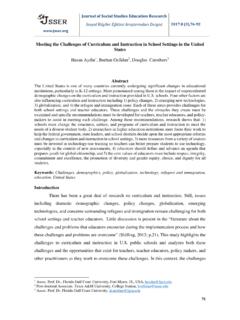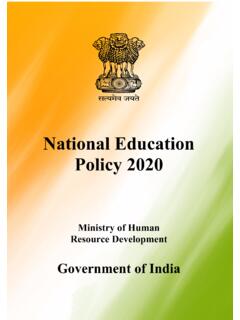Transcription of Breaking Down Barriers: Academic Obstacles of First ...
1 Breaking down barriers : Academic Obstacles of First - generation students at Research UniversitiesMICHAEL J. STEBLETON AND KRISTA M. SORIAUNIVERSITY OF MINNESOTA - TWIN CITIESA bstractThe purpose of this study was to examine the perceived Academic Obstacles of First - generation students in comparison to non- First - generation students . Using the Student Experience in the Research University (SERU) completed by approximately 58,000 students from six research universities, the researchers used nonparametric bootstrapping to analyze differences between First - generation and non- First - generation students Obstacles to Academic success.
2 The results suggest that First - generation students more frequently encounter Obstacles that compromise their Academic success as compared to non- First - generation students , such as job responsibilities, family responsibilities, perceived weak English and math skills, inadequate study skills, and feelings of depression. Implications for learning assistance professionals are : First - generation ; retention; student success; high impact practices; support servicesAs learning assistance center professionals, tutors, and college educators seek to develop innovative strategies to assist students in meeting their Academic goals, they may find value in targeting services to address the distinct needs of historically underserved student populations.
3 One growing population of unique college students First - generation students may face challenges related to navigating the maze of higher education. This paper examines some of the Academic Obstacles faced by First - generation students and describes strategies that learning center practitioners and faculty members can use to assist these students with achieving Academic excellence. A variety of definitions have been used to describe First - generation students in the higher education and college student development literature, and each definition has subsequent consequences for students , institutions, and organizations.
4 The authors of this article defined First - generation status as neither parent having earned a bachelor s degree; the same definition is used by federal TRIO programs and other organizations. In the present study, college students were considered First - generation even if their parents had some post-secondary education and/or an associate s more information contact: Michael Stebleton | Department of Postsecondary Teach-ing and Learning | University of Minnesota - Twin Cities| Minneapolis, MN 55455| Email Review The profile of First - generation students comprises certain characteristics.
5 First - generation students are more likely than their non- First - generation counterparts to have additional characteristics that may serve as a disadvantage as they pursue their college education. First - generation students are more likely to be older, come from minority backgrounds, and have a disability (Bui, 2002; Hertel, 1992). Additionally, First - generation students are more likely to be non-native English speakers, immigrants ( , born outside of the ), single parents, and financially independent from their parents (Bui, 2002).
6 They tend to have lower levels of Academic preparation and frequently need to be employed (often full-time) to help pay for educational and cost-of-living expenses (Jehangir, 2010). First - generation students tend to have lower graduation rates than their non- First generation peers (Engle & Tinto, 2008). According to Engle and Tinto, research has shown that low-income and First - generation students are less likely to be engaged in the Academic and social experiences that foster success in college, such as studying in groups, interacting with faculty and other students , participating in extracurricular activities, and using support services (p.)
7 3). These challenges can be exacerbated by enrolling at large, research universities where classes tend to be larger and interactions with faculty members can be infrequent (Kim, 2009). Although institutions of higher education generally have done a better job of promoting college access to First - generation students , college success as measured by persistence and graduation rates ( , retention of First - generation students ) continues to be a problem (Engle & Tinto, 2008; Pascarella, Pierson, Wolniak, & Terenzini, 2004).
8 Data from the National Center for Education Statistics Beginning Postsecondary Study describe the situation for First - generation students in terms of college success. First - generation , low-income students were nearly four times more likely (26% to 7%) to leave higher education after the First year than non- First - generation students (Engle & Tinto, 2008). Six years later, nearly half (43%) of low-income First generation students had left college without earning their degrees. Among those who did not continue, nearly two-thirds (60%) did so after the First year.
9 First - generation students often face multiple unique barriers to post-secondary success (Jehangir, 2010). For example, First - generation students often bridge two cultures, not feeling a sense of belonging in either one (Oldfield, 2007; Rend n, 1992). barriers can relate to issues that deal with family, social, cultural, and Academic transitions (London, 1989). This lack of belonging or isolation can lead to feelings of depression and loneliness for First - generation students (Lippincott & German, 2007). Additionally, due to family and work demands, First - generation students tend not to be as academically engaged as their non- First - generation peers (Kuh, 2008).
10 Kuh discovered that First - generation and other historically underserved students tend not to participate in high impact educational practices as frequently as traditional students despite evidence that they benefit from participation on par or even more so than their non- First - 8 | TLAR, Volume 17, Number 2generation peers. These practices include intentional engagement activ-ities such as learning communities, First -year seminars, common book experiences, study abroad opportunities, and other experiences that enhance the undergraduate experience.












